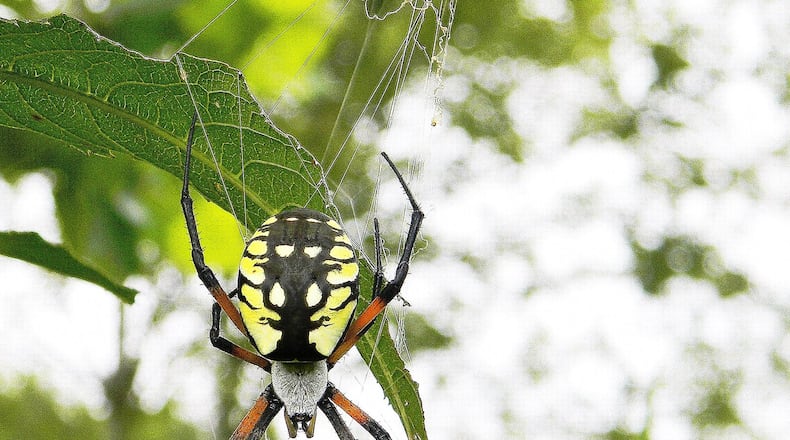This is the time of year when the huge spiders known as orbweavers seem to emerge out of nowhere, causing folks to wonder where the creatures have been hiding all this time.
Actually, they’ve been with us since early spring, when they hatched out as tiny, barely noticeable babies from eggs that were laid last fall. Through spring and summer, they steadily consumed insects and other prey and grew bigger. As they grew, their webs, also small and inconspicuous earlier in the year, got bigger.
Now, the spiders are mature, large and very visible. Their wheel-shaped webs are humongous.
The big webs seem to be everywhere — stretched between shrubs and trees on trails and garden paths or across porches, windows and decks. If you go outside, chances are good that you’ll encounter one of the sticky webs.
One common orbweaver, the yellow garden spider, is one of Georgia’s longest spiders this time of year, as long as four inches for the female. Her abdomen has distinctive yellow and black markings while the front part of the body is white. Found in gardens and around shrubbery, the spider builds webs several feet wide that have a zigzag of silk through the middle; hence, the spider’s other common name, “writing spider.”
Some other common orbweavers now are the basilica, golden silk, arrowhead and barn spiders. Some may bite, but they are not dangerous.
The barn spider is the model for Charlotte in E.B. White’s famous children’s book “Charlotte’s Web.” Despite their name, barn spiders can be found on porches, where flying insects attracted to porch lights get trapped in their webs. The spiders hide during the day, but at night they sit in the middle of the web waiting for their meals to come along.
Soon, the orbweavers will mate and lay eggs that will hatch next spring. The parents, though, will perish with the first frost.
IN THE SKY: From David Dundee, Tellus Science Museum astronomer: The moon will be full on Sunday — the Fruit Moon, as the Cherokee peoples called this this month’s full moon. Brilliant Venus is low in the west just after dark and sets about two hours later. Mars, also shining brightly, is in the east at dusk. Jupiter is in the southwest at dusk. Saturn is high in the south just after dark.
About the Author
Keep Reading
The Latest
Featured


